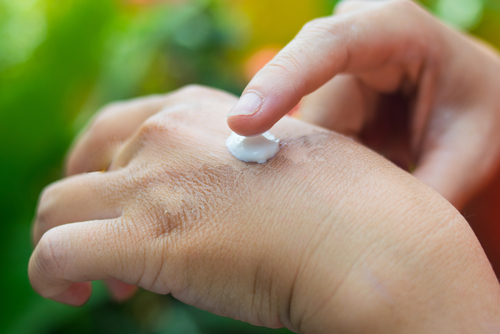First RDEB Adult Patients Do Well in Clinical Trial with Gene Therapy KB103
Written by |

The first two adults with recessive dystrophic epidermolysis bullosa (RDEB) treated with the topical gene therapy candidate KB103 experienced increased levels of functional human collagen 7 (COL7) protein and anchoring collagen fibril formation, a Phase 1/2 clinical trial shows.
Moreover, wounds treated with topical KB103 closed in two weeks and remain closed as of the Oct. 15 announcement, while control wounds (those not treated with KB103) took 10 weeks to close. No safety issues were detected with KB103, even after repeated administrations.
KB103, developed using Krystal Biotech’s STAR-D platform, delivers a normal and functional copy of the COL7A1 gene to skin cells, through a modified herpes simplex virus (HSV-1) unable to cause disease. Mutations in the COL7A1 gene are the underlying cause of DEB, and lead to a defective production of COL7 protein, causing layers of the skin to separate and form skin blisters.
The Phase 1/2 study (NCT03536143), underway at Stanford University, is evaluating the safety and tolerability of KB103 in people with the recessive type of DEB, the most severe form of the disease. The trial expects to enroll a total of six patients, three adults and three children, aged five or older. Patients will be followed for four months.
The therapy’s effectiveness also is evaluated through wound imaging, and analysis of COL7 expression and the formation of anchoring collagen fibrils (which guarantee skin integrity).
To date, two adult RDEB patients, age 35 and 28, completed the study. They were randomized to receive topical KB103 or a placebo (control) in two wounds (surface area of approximately 10 cm2). Additionally, they received an intradermal (within the skin layers) injection of KB103 into an intact piece of skin to assess the therapy’s mechanism of action.
In one of the patients, the wound treated with KB103 closed in two weeks, while the one treated with placebo took 10 weeks to close. The same rate of two-week closure was seen in the second patient, while its placebo-treated wound failed to completely close.
Moreover, KB103-treated wounds in both patients remain close to date, totaling 4.5 and 3.5 months of total closure in patient 1 and patient 2, respectively.
Administration of KB103 increased the levels of functional COL7 protein, as shown by imaging analysis of a skin biopsy. Also, repeated administration of KB103 in both patients continued to increase COL7 expression without triggering any safety issue, including inflammation or irritation.
“Results on 2 patients demonstrate a meaningful clinical benefit and suggest that KB103 can afford a simple, convenient, painless way to administer treatment for patients suffering with this debilitating disease,” Peter Marinkovich, MD, associate professor of dermatology at Stanford University and study lead investigator, said in a press release.
Data on the clinical responses from both patients was sent to the U.S. Food and Drug Administration (FDA), which has acknowledged the therapy’s successful mechanism of action by increasing the levels of COL7 and anchoring fibrils. As a result, the trial protocol was amended, and the intradermal KB103 injection is no longer a requirement for future patients enrolled in the Phase 1/2 trial.
After discussions with the FDA, the trial will begin to enroll children and the focus of the study will be to assess the durability of wound closure. The revised protocol also allows the team to test increasing doses of KB103 and its administration to larger wounds.
“These early data are encouraging and we look forward to continuing the study in pediatric populations,” Marinkovich said.
The completion of the Phase 1/2 trial is expected in the first half of 2019, and the launch of a Phase 3 trial is planned in the second half of 2019.
In May, 2018 the U.S. Food and Drug Administration granted fast-track designation to KB103 for the treatment of DEB. Fast track designation intends to expedite both the development and review of the application for approval. It is designed to deliver new therapies for rare and serious diseases to patients more quickly.





